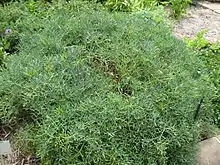Crithmum
Crithmum is a monospecific genus of flowering plant in the carrot family Apiaceae, with the sole species Crithmum maritimum, known as rock samphire,[1][2] sea fennel[1] or samphire.[1] The name "samphire" is also used for several other unrelated succulent halophyte species of coastal plant.
| Samphire | |
|---|---|
 | |
| Scientific classification | |
| Kingdom: | Plantae |
| Clade: | Tracheophytes |
| Clade: | Angiosperms |
| Clade: | Eudicots |
| Clade: | Asterids |
| Order: | Apiales |
| Family: | Apiaceae |
| Subfamily: | Apioideae |
| Tribe: | Pyramidoptereae |
| Genus: | Crithmum L. |
| Species: | C. maritimum |
| Binomial name | |
| Crithmum maritimum | |



Sea fennel, or Rock samphire, is an edible wild plant. It is found on southern and western coasts of Britain and Ireland, on Mediterranean and western coasts of Europe and in the Canary Islands, North Africa and on the coast of the Black Sea.
History, trade and cultivation
In the 17th century, Shakespeare in King Lear referred to the dangerous practice of collecting rock samphire from cliffs. "Half-way down, Hangs one that gathers samphire; dreadful trade!"[3] In the 19th century, samphire was being shipped in casks of seawater from the Isle of Wight to market in London at the end of May each year.[4] Rock samphire used to be cried in London streets as "Crest Marine".[5]
In England, rock samphire was cultivated in gardens,[5] where it grows readily in a light, rich soil. Obtaining seed commercially is now difficult, and in the United Kingdom the removal of wild plants is illegal under the Wildlife and Countryside Act 1981.
The reclaimed piece of land adjoining Dover, called Samphire Hoe, is named after rock samphire. The land was created from spoil from the Channel Tunnel, and rock samphire used to be harvested from the neighbouring cliffs.
Culinary use
Rock samphire or sea fennel has fleshy, divided aromatic leaves that Culpeper described as having a "pleasant, hot and spicy taste"[6]
The stems, leaves and seed pods may be pickled in hot, salted, spiced vinegar, or the leaves used fresh in salads.
Sea fennel pickle in olive oil or vinegar is a traditional food of Italy (Marche region), Croatia (Dalmatia), and Montenegro (Bay of Kotor). It is known as Paccasassi del Conero and used as an antipasto, to accompany fish and meat dishes and to garnish pizza and sandwiches.
Richard Mabey gives several recipes for rock samphire,[7] although it is possible that at least one of these may refer to marsh samphire or glasswort (Salicornia europaea), a very common confusion.
Properties
Sea fennel has nutritional value, being rich in vitamin C, vitamins E and K, iodine, carotenoids and flavonoids. It is also rich in antioxidants and in omega-3 fatty acids. The consumption of sea fennel was common among seafarers as a valuable aid for the prevention of scurvy.
References
- "Crithmum maritimum". Germplasm Resources Information Network (GRIN). Agricultural Research Service (ARS), United States Department of Agriculture (USDA). Retrieved 13 March 2014.
- "BSBI List 2007". Botanical Society of Britain and Ireland. Archived from the original (xls) on 23 October 2014. Retrieved 2014-10-17.
- Shakespeare, William (1623). The Tragedy of King Lear. London. Act IV, scene VI, lines 14b-15
- Grigson, Geoffrey (1958). The Englishman's Flora. London: The Readers' Union, Phoenix House.
- Phillips, Roger (1983). Wild Food. Pan. ISBN 0-330-28069-4.
- Culpeper, Nicholas (1653). The Complete Herbal. London.
- Mabey, Richard (1975). Food For Free. Fontana. ISBN 0-00-613470-X.
External links
- BBC Gardeners' Question Time – where there is apparently some confusion between the glasswort (marsh samphire, found in Suffolk) and the rock samphire (found in Dorset).
- Biff Vernon discusses the common confusion between marsh samphire and rock samphire, and reproduces a poem on the subject by William Logan.
- Botanical.com
- Rinci.it
- PubMed.gov
- PubMed.gov
| Wikimedia Commons has media related to Crithmum maritimum. |